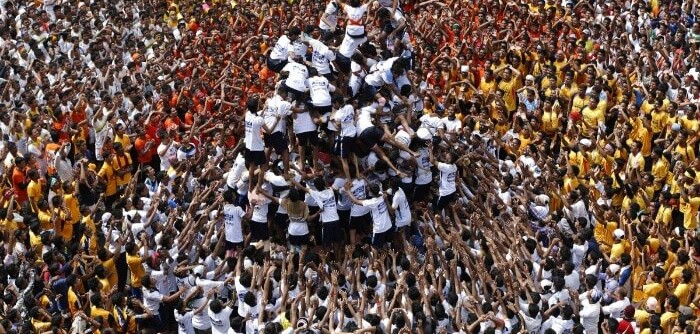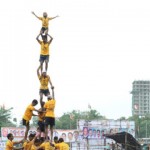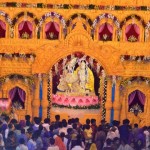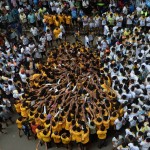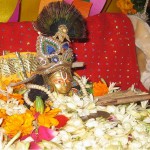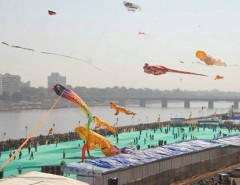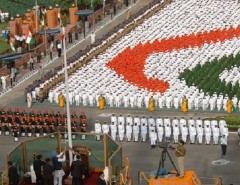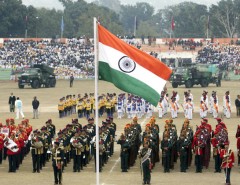Krishna Janmashtami (Devanagari कृष्ण जन्माष्टमी kṛṣṇa janmāṣṭamī), also known as Krishnashtami, Saatam Aatham, Gokulashtami, Ashtami Rohini, Srikrishna Jayanti, Sree Jayanti or sometimes simply as Janmashtami, is an annual celebration of the birth of the Hindu deity Krishna, the eighth avatar of Vishnu.
The festival is celebrated on the eighth day (Ashtami) of the Krishna Paksha (dark fortnight) of the month of Shravana (August–September) in the Hindu calendar.Rasa lila, dramatic enactments of the life of Krishna, are a special feature in regions of Mathura and Vrindavan, and regions following Vaishnavism in Manipur. While the Rasa lila re-creates the flirtatious aspects of Krishna’s youthful days, the Dahi Handi celebrate God’s playful and mischievous side, where teams of young men form human towers to reach a high-hanging pot of curd and break it. This tradition, also known as uriadi, is a major event in Tamil Nadu on Gokulashtami. Krishna Janmashtami is followed by the festival Nandotsav, which celebrates the occasion when Nanda Baba distributed gifts to the community in honour of the birth.
Legend
Krishna was the eighth son of Devaki and Vasudeva. Based on scriptural details and astrological calculations, the date of Krishna’s birth, known as Janmashtami, is 18 July 3228 BCE and he lived until 18 February 3102 BCE. Krishna belonged to the Vrishni clan of Yadavas from Mathura, and was the eighth son born to the princess Devaki and her husband Vasudeva.
Mathura (in present-day Mathura district, Uttar Pradesh) was the capital of the Yadavas, to which Krishna’s parents Vasudeva and Devaki belonged. King Kansa, Devaki’s brother, had ascended the throne by imprisoning his father, King Ugrasena. Afraid of a prophecy that predicted his death at the hands of Devaki’s eighth son, Kansa had the couple locked in a prison cell. After Kansa killed the first six children, and Devaki’s apparent miscarriage of the seventh (which was actually a secret transfer of the infant to Rohini as Balarama), Krishna was born.
Following the birth, Vishnu ordered Vasudeva to take Krishna to Gokul to Nanda and Yashoda, where he could live safely, away from his Uncle Kansa. Vasudeva took Krishna with him and crossed the Yamuna to reach Gokul. There, everyone was asleep; so he quietly kept him there and returned with Yashoda’s daughter. Kansa, thinking her to be Devki’s eight child, threw her on a stone. But she rose into the air and transformed into Yogmaya (who is Vishnu’s helper) and warned Kansa about his death. Then, she disappeared. Krishna grew up in Gokul with his brother, Balram. He then returned to Mathura and killed Kansa with the help of Balram.
Lord Krishna kkis given the holy bath between 8 – 10 am and devotees are given a chance to see the abhishek, which happens only twice a year. The bath is given right after the mangla arti with Panchamrit –which is a mixture of gangajal, ghee, honey, curd and sugar. After the bath, Lord Krishna is adorned with pitambar, yellow colored clothes and ornaments. Ornaments consists of Chandanmala, Vyjantimala, made of flowers and Suparimala made of Betel nut. After the adornment of Shri Krishna, the curtains are removed and devotees are allowed to do the darshan of the Lord. This is followed by offering of Shringar Bhog to the Lord Krishna.
During this ritual, the curtains are down again and darshans are not allowed. After the evening arti, Lord is offered sweets again; devotees are not allowed the darshans of the Lord during this time. Then it is time for Dwarkadhish to sleep. This happens around 9:00 pm. It is around 10:30 pm that darshans are opened again for the devotees during the Janmashtami celebrations.
Lord Dwarkadhish is adorned with lot of Gold jewellery and other precious stones such as Diamonds and Topaz. Utsav Bhog is offered to Lord around 11:30 pm. Devotees are not allowed to see the process of Utsav Bhog though they wait eagerly for their beloved Lord in the temple premises and sing bhajans. The devotees welcome the Lord at 12 midnight with immense enthusiasm and joy by chanting “Nand Gher Anand Bhayo- Jay Kanaiya lal ki”. After nearly two-hour celebrations, the temple closes at 2:00 am after the mahabhog offerings to Lord Krishna.
In Gujarat, markets are also filled up with idols of Bal-Krishna and colorful swings. Every temple and house hold has decorated swings with Bal-Krishna-idol in colorful costumes sitting on it. The main Prasad known as PANCHAJIRI-or PANJARI is also work as protection against the seasonal disorder in people, as it made from five important elements of Ayurveda.
Apart from Dwarka, the people of Gujarat also visit Mathura, Dakor, Shrinathdwara and Shamlaji- for pilgrimage. Krishna Janmashtrami in Gujarat is also celebrated as festival of fairs in the state. Most of these fairs have been organized in towns and cities of Saurashtra region, which displays the rich culture and traditions of rural folklore.

